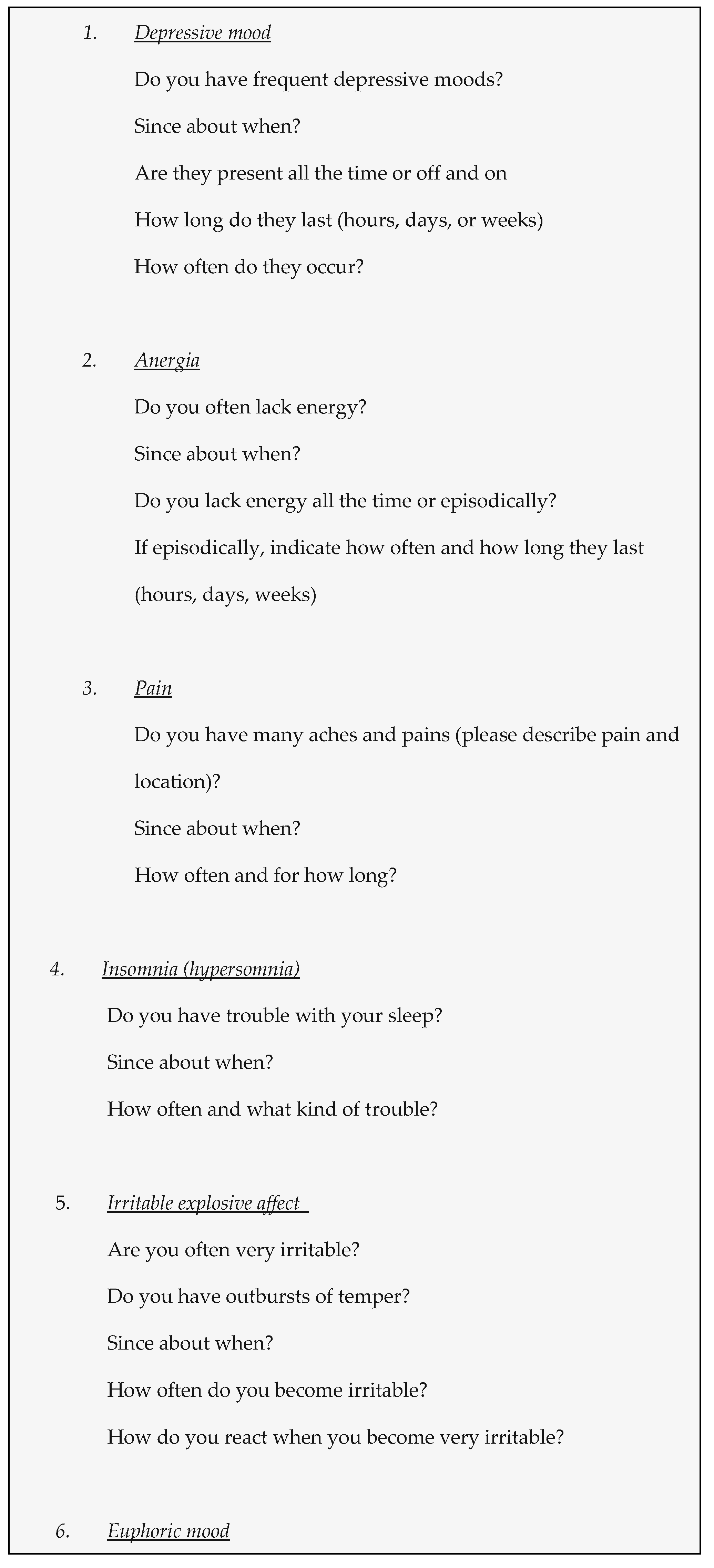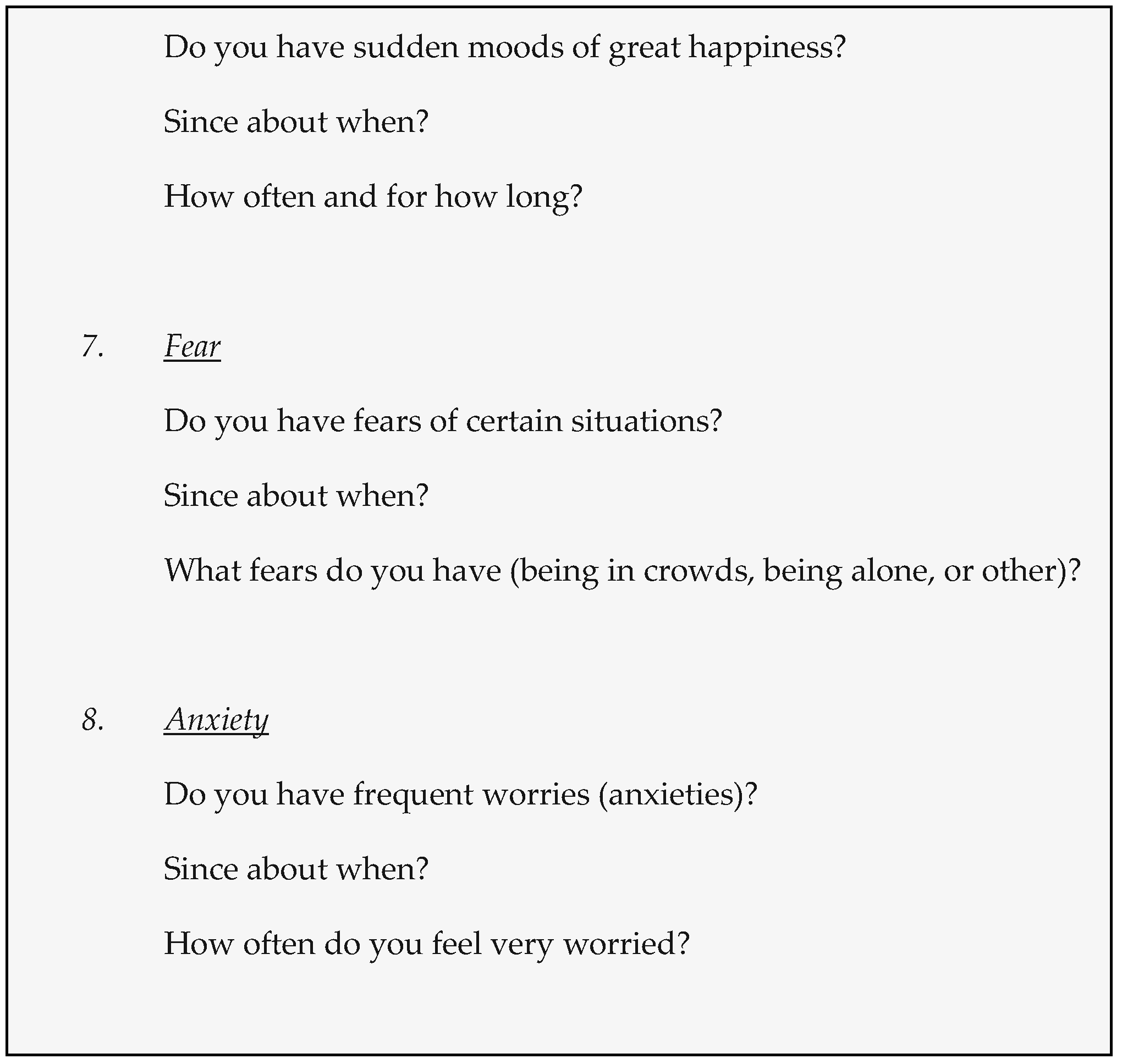Dysphoria and Irritability—Diagnostic Pitfalls in the Assessment of Interictal Dysphoric Disorder in Epilepsy
Abstract
1. Introduction
2. Impact of IDD and Psychiatric Comorbidity on Quality of Life and Risk of Suicide
3. Assessment of IDD
4. Mood Dimensions
4.1. Dysphoria
4.2. Irritability
4.3. Periictal Mood Changes
4.4. Emotional Dysregulation
5. Diagnostic Difficulties of IDD in Clinical Practice and Therapeutic Approach
5.1. Screening for Mood Disorders in Epilepsy
5.2. Therapeutic Approach for IDD
6. Conclusions
Author Contributions
Funding
Institutional Review Board Statement
Informed Consent Statement
Conflicts of Interest
References
- Blumer, D.; Montouris, G.; Davies, K. The Interictal Dysphoric Disorder: Recognition, Pathogenesis, and Treatment of the Major Psychiatric Disorder of Epilepsy. Epilepsy Behav. 2004, 5, 826–840. [Google Scholar] [CrossRef]
- Mula, M.; Jauch, R.; Cavanna, A.; Collimedaglia, L.; Barbagli, D.; Gaus, V.; Kretz, R.; Viana, M.; Tota, G.; Israel, H.; et al. Clinical and Psychopathological Definition of the Interictal Dysphoric Disorder of Epilepsy. Epilepsia 2008, 49, 650–656. [Google Scholar] [CrossRef]
- Schmitz, B. Depression and Mania in Patients with Epilepsy. Epilepsia 2005, 46, 45–49. [Google Scholar] [CrossRef]
- Wiglusz, M.S.; Landowski, J.; Michalak, L.; Cubała, W.J. Reevaluating the Prevalence and Diagnostic Subtypes of Depressive Disorders in Epilepsy. Epilepsy Behav. 2015, 53, 15–19. [Google Scholar] [CrossRef] [PubMed]
- Arlington, V.A.; Association, A.P. Diagnostic and Statistical Manual of Mental Disorders. Am. Psychiatr. Assoc. 2013, 5, 612–613. [Google Scholar]
- Kraepelin, E. Psychiatrie. Band 3; Johann Ambrosius Barth: Leipzig, Germany, 1923. [Google Scholar]
- Bleuler, E. Textbook of Psychiatry; The Macmillan, Co.: New York, NY, USA, 1924. [Google Scholar]
- Mula, M. The Interictal Dysphoric Disorder of Epilepsy: A Still Open Debate. Curr. Neurol. Neurosci. Rep. 2013, 13, 355. [Google Scholar] [CrossRef] [PubMed]
- Mula, M. The Interictal Dysphoric Disorder of Epilepsy: Legend or Reality? Epilepsy Behav. 2016, 58, 7–10. [Google Scholar] [CrossRef] [PubMed]
- Amiri, M.; Hansen, C.P. The Interictal Dysphoric Disorder in Patients with Epilepsy: A Doubtful Disorder Lacking Diagnostic Tools. Seizure—Eur. J. Epilepsy 2015, 24, 70–76. [Google Scholar] [CrossRef] [PubMed]
- Labudda, K.; Illies, D.; Bien, C.G.; Neuner, F. Interictal Dysphoric Disorder: Further Doubts about Its Epilepsy-Specificity and Its Independency from Common Psychiatric Disorders. Epilepsy Res. 2018, 141, 13–18. [Google Scholar] [CrossRef]
- Starcevic, V. Dysphoric About Dysphoria: Towards a Greater Conceptual Clarity of the Term. Australas. Psychiatry 2007, 15, 9–13. [Google Scholar] [CrossRef]
- Starcevic, V.; Rossi Monti, M.; D’Agostino, A.; Berle, D. Will DSM-5 Make Us Feel Dysphoric? Conceptualisation(s) of Dysphoria in the Most Recent Classification of Mental Disorders. Aust. N. Z. J. Psychiatry 2013, 47, 954–955. [Google Scholar] [CrossRef]
- Toohey, M.J.; Di Giuseppe, R. Defining and Measuring Irritability: Construct Clarification and Differentiation. Clin. Psychol. Rev. 2017, 53, 93–108. [Google Scholar] [CrossRef]
- Vidal-Ribas, P.; Brotman, M.A.; Valdivieso, I.; Leibenluft, E.; Stringaris, A. The Status of Irritability in Psychiatry: A Conceptual and Quantitative Review. J. Am. Acad. Child Adolesc. Psychiatry 2016, 55, 556–570. [Google Scholar] [CrossRef]
- Boylan, L.S.; Flint, L.A.; Labovitz, D.L.; Jackson, S.C.; Starner, K.; Devinsky, O. Depression but not seizure frequency predicts quality of life in treatment-resistant epilepsy. Neurology 2004, 62, 258–261. [Google Scholar] [CrossRef] [PubMed]
- Christensen, J.; Vestergaard, M.; Mortensen, P.B.; Sidenius, P.; Agerbo, E. Epilepsy and risk of suicide: A population-based case–control study. Lancet Neurol. 2007, 6, 693–698. [Google Scholar] [CrossRef]
- Hesdorffer, D.C.; Ishihara, L.; Mynepalli, L.; Webb, D.J.; Weil, J.; Hauser, W.A. Epilepsy, suicidality, and psychiatric disorders: A bidirectional association. Ann. Neurol. 2012, 72, 184–191. [Google Scholar] [CrossRef] [PubMed]
- Suda, T.; Tatsuzawa, Y.; Mogi, T.; Yoshino, A. Interictal dysphoric disorder in patients with localization-related epilepsy: Diagnostic relationships with DSM-IV psychiatric disorders and the impact of psychosocial burden. Epilepsy Behav. 2016, 54, 142–147. [Google Scholar] [CrossRef]
- Blumer, D.; Montouris, G.; Hermann, B. Psychiatric Morbidity in Seizure Patients on a Neurodiagnostic Monitoring Unit. JNP 1995, 7, 445–456. [Google Scholar] [CrossRef]
- Blumer, D.; Wakhlu, S.; Davies, K.; Hermann, B. Psychiatric Outcome of Temporal Lobectomy for Epilepsy: Incidence and Treatment of Psychiatric Complications. Epilepsia 1998, 39, 478–486. [Google Scholar] [CrossRef] [PubMed]
- Feighner, J.P.; Robins, E.; Guze, S.B.; Woodruff, R.A., Jr.; Winokur, G.; Munoz, R. Diagnostic Criteria for Use in Psychiatric Research. Arch. Gen. Psychiatry 1972, 26, 57–63. [Google Scholar] [CrossRef]
- Appelbaum, P.S. Moving Toward the Future in the Diagnosis of Mental Disorders. Psychol. Sci. Public Interest 2017, 18, 67–71. [Google Scholar] [CrossRef]
- Clark, L.A.; Cuthbert, B.; Lewis-Fernández, R.; Narrow, W.E.; Reed, G.M. Three Approaches to Understanding and Classifying Mental Disorder: ICD-11, DSM-5, and the National Institute of Mental Health’s Research Domain Criteria (RDoC). Psychol. Sci. Public Interest 2017, 18, 72–145. [Google Scholar] [CrossRef] [PubMed]
- Awad, A.G.; Voruganti, L.N.P. Neuroleptic Dysphoria: Revisiting the Concept 50 Years Later. Acta Psychiatr. Scand. 2005, 111, 6–13. [Google Scholar] [CrossRef] [PubMed]
- EI-Mallakh, R.S.; Karippot, A. Antidepressant-Associated Chronic Irritable Dysphoria (Acid) in Bipolar Disorder: A Case Series. J. Affect. Disord. 2005, 84, 267–272. [Google Scholar] [CrossRef] [PubMed]
- El-Mallakh, R.S.; Gao, Y.; Jeannie Roberts, R. Tardive Dysphoria: The Role of Long Term Antidepressant Use in-Inducing Chronic Depression. Med. Hypotheses 2011, 76, 769–773. [Google Scholar] [CrossRef] [PubMed]
- Blumer, D.; Herzog, A.G.; Himmelhoch, J.; Salgueiro, C.A.; Ling, F.W. To What Extent Do Premenstrual and Interictal Dysphoric Disorder Overlap? Significance for Therapy. J. Affect. Disord. 1998, 48, 215–225. [Google Scholar] [CrossRef]
- Bertschy, G.; Gervasoni, N.; Favre, S.; Liberek, C.; Ragama-Pardos, E.; Aubry, J.-M.; Gex-Fabry, M.; Dayer, A. Frequency of Dysphoria and Mixed States. Psychopathology 2008, 41, 187–193. [Google Scholar] [CrossRef]
- Barahmand, U.; Haji, A. The Impact of Intolerance of Uncertainty, Worry and Irritability on Quality of Life in Persons with Epilepsy: Irritability as Mediator. Epilepsy Res. 2014, 108, 1335–1344. [Google Scholar] [CrossRef]
- Piazzini, A.; Turner, K.; Edefonti, V.; Bravi, F.; Canevini, M.P.; Ferraroni, M. A New Italian Instrument for the Assessment of Irritability in Patients with Epilepsy. Epilepsy Behav. 2011, 21, 275–281. [Google Scholar] [CrossRef]
- Kwon, O.-Y.; Park, S.-P. Interictal Irritability and Associated Factors in Epilepsy Patients. Seizure—Eur. J. Epilepsy 2016, 42, 38–43. [Google Scholar] [CrossRef][Green Version]
- Mula, M. The Clinical Spectrum of Bipolar Symptoms in Epilepsy: A Critical Reappraisal. Postgrad. Med. 2010, 122, 17–23. [Google Scholar] [CrossRef]
- Wiglusz, M.S.; Landowski, J.; Cubała, W.J.; Agius, M. Overlapping Phenomena of Bipolar Disorder and Epilepsy–a Common Pharmacological Pathway. Psychiatr Danub 2015, 27 (Suppl. 1), S177–S181. [Google Scholar] [PubMed]
- Wiglusz, M.S.; Cubała, W.J.; Gałuszko-Węgielnik, M.; Jakuszkowiak-Wojten, K.; Landowski, J. Mood Disorders in Epilepsy-Diagnostic and Methodological Considerations. Psychiatr Danub 2012, 24 (Suppl. 1), S44–S50. [Google Scholar] [PubMed]
- Mula, M.; Jauch, R.; Cavanna, A.; Gaus, V.; Kretz, R.; Collimedaglia, L.; Barbagli, D.; Cantello, R.; Monaco, F.; Schmitz, B. Interictal Dysphoric Disorder and Periictal Dysphoric Symptoms in Patients with Epilepsy. Epilepsia 2010, 51, 1139–1145. [Google Scholar] [CrossRef]
- Gaitatzis, A.; Trimble, M.R.; Sander, J.W. The Psychiatric Comorbidity of Epilepsy. Acta Neurol. Scand. 2004, 110, 207–220. [Google Scholar] [CrossRef] [PubMed]
- Blanchet, P.; Frommer, G.P. Mood Change Preceding Epileptic Seizures. J. Nerv. Ment. Dis. 1986, 174, 471–476. [Google Scholar] [CrossRef]
- Kanner, A.M.; Soto, A.; Gross-Kanner, H. Prevalence and Clinical Characteristics of Postictal Psychiatric Symptoms in Partial Epilepsy. Neurology 2004, 62, 708. [Google Scholar] [CrossRef]
- Mula, M.; Schmitz, B.; Jauch, R.; Cavanna, A.; Cantello, R.; Monaco, F.; Trimble, M.R. On the Prevalence of Bipolar Disorder in Epilepsy. Epilepsy Behav. 2008, 13, 658–661. [Google Scholar] [CrossRef] [PubMed]
- D’Agostino, A.; Covanti, S.; Rossi Monti, M.; Starcevic, V. Reconsidering Emotion Dysregulation. Psychiatr. Q. 2017, 88, 807–825. [Google Scholar] [CrossRef] [PubMed]
- Erdoğan Taycan, S.; Taycan, O. Affective Temperament Profiles and Clinical Correlates in Patients with Epilepsy: A Link from Mood Disorders. J. Affect. Disord. 2014, 164, 1–4. [Google Scholar] [CrossRef]
- Zinchuk, M.; Kustov, G.; Pashnin, E.; Pochigaeva, K.; Rider, F.; Yakovlev, A.; Hesdorffer, D.; Hauser, W.A.; Guekht, A. Interictal Dysphoric Disorder in People with and without Epilepsy. Epilepsia 2021, 62, 1382–1390. [Google Scholar] [CrossRef] [PubMed]
- Kanner, A.M.; Barry, J.J. Is the psychopathology of epilepsy different from that of nonepileptic patients? Epilepsy Behav. 2001, 2, 170–186. [Google Scholar] [CrossRef] [PubMed]
- Gilliam, F.G.; Barry, J.J.; Hermann, B.P.; Meador, K.J.; Vahle, V.; Kanner, A.M. Rapid detection of major depression in epilepsy: A multicentre study. Lancet Neurol. 2006, 5, 399–405. [Google Scholar] [CrossRef]
- Cramer, J.A.; Blum, D.; Reed, M.; Fanning, K. The infl uence of comorbid depression on quality of life for people with epilepsy. Epilepsy Behav. 2003, 4, 515–521. [Google Scholar] [CrossRef]


Publisher’s Note: MDPI stays neutral with regard to jurisdictional claims in published maps and institutional affiliations. |
© 2021 by the authors. Licensee MDPI, Basel, Switzerland. This article is an open access article distributed under the terms and conditions of the Creative Commons Attribution (CC BY) license (https://creativecommons.org/licenses/by/4.0/).
Share and Cite
Grzegorzewska, A.M.; Wiglusz, M.S.; Cubała, W.J.; Jakuszkowiak-Wojten, K.; Włodarczyk, A.; Szarmach, J. Dysphoria and Irritability—Diagnostic Pitfalls in the Assessment of Interictal Dysphoric Disorder in Epilepsy. J. Clin. Med. 2021, 10, 4624. https://doi.org/10.3390/jcm10194624
Grzegorzewska AM, Wiglusz MS, Cubała WJ, Jakuszkowiak-Wojten K, Włodarczyk A, Szarmach J. Dysphoria and Irritability—Diagnostic Pitfalls in the Assessment of Interictal Dysphoric Disorder in Epilepsy. Journal of Clinical Medicine. 2021; 10(19):4624. https://doi.org/10.3390/jcm10194624
Chicago/Turabian StyleGrzegorzewska, Agata M., Mariusz S. Wiglusz, Wiesław J. Cubała, Katarzyna Jakuszkowiak-Wojten, Adam Włodarczyk, and Joanna Szarmach. 2021. "Dysphoria and Irritability—Diagnostic Pitfalls in the Assessment of Interictal Dysphoric Disorder in Epilepsy" Journal of Clinical Medicine 10, no. 19: 4624. https://doi.org/10.3390/jcm10194624
APA StyleGrzegorzewska, A. M., Wiglusz, M. S., Cubała, W. J., Jakuszkowiak-Wojten, K., Włodarczyk, A., & Szarmach, J. (2021). Dysphoria and Irritability—Diagnostic Pitfalls in the Assessment of Interictal Dysphoric Disorder in Epilepsy. Journal of Clinical Medicine, 10(19), 4624. https://doi.org/10.3390/jcm10194624





